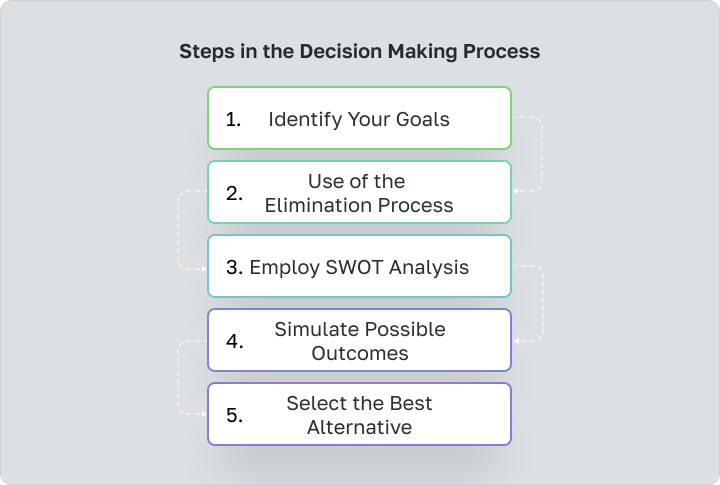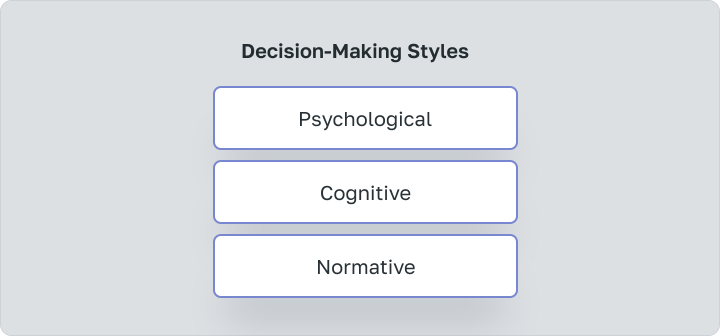Welcome to our comprehensive guide on the intricacies of management decision making. In today’s dynamic business landscape, effective decision-making is paramount for organizational success. This article delves into the multifaceted types of decision making processes, exploring its various stages, methodologies, and essential tools. From identifying problems to evaluating alternatives and implementing solutions, we’ll navigate through the strategies and frameworks that empower leaders to make informed and impactful decisions.
Whether you’re a seasoned executive or a budding manager, this guide aims to equip you with the knowledge and insights necessary to navigate the complexities of decision-making in project management with confidence and proficiency.
Introduction to Management Decision Making
What is Management Decision Making?
Decision making in management refers to the process by which managers analyze issues, evaluate alternatives, and choose the most appropriate course of action to achieve organizational objectives. It’s the cornerstone of effective leadership, as managerial decisions shape the direction, performance, and sustainability of an organization.

Management decision-making ensures resource optimization, risk mitigation, and alignment with strategic goals. In today’s fast-paced and competitive business environment, adept decision-makers are crucial for organizational success, as they navigate complexities, capitalize on opportunities, and drive innovation. Ultimately, the ability to find a well-informed and timely solution distinguishes thriving organizations from those that falter.
Characteristics of Effective Management Decision Making
Effective managerial decision making hinges on several key qualities:
- Rational-thinking ensures decisions are based on logical analysis rather than emotions.
- Process-oriented approaches ensure systematic and thorough evaluation of options.
- Selectivity ensures focus on relevant information, avoiding paralysis.
- Purposive decision making in project management aligns with organizational goals and strategies.
- Maintaining a positive outlook fosters creativity and resilience in the face of challenges.
- Commitment ensures decisions in project management are followed through with dedication and accountability.
- Lastly, evaluation allows for continuous improvement by assessing outcomes and learning from experiences, thereby enhancing future decision-making efficacy.
 Rational-thinking
Rational-thinking
Rational thinking, logic and reason are essential in project management decision-making as they provide a foundation for sound judgments. By employing rational-thinking, managers can systematically analyze information, identify cause-effect relationships, and anticipate potential outcomes.

This approach minimizes the influence of biases and emotions, leading to more objective and evidence-based decision making. Rational-thinking fosters clarity of thought, enabling managers to weigh alternatives effectively and choose the most advantageous course of action for their organization’s goals and long-term success.
 Process-Oriented
Process-Oriented
A structured approach to decision-making, characterized by being process-oriented, ensures thoroughness and consistency. By following a defined process, managers can systematically gather relevant information, assess alternatives, and anticipate potential risks and benefits from management. This structured approach to decision making in project management reduces the likelihood of overlooking critical factors and enhances solution quality.

Moreover, it facilitates communication and collaboration within the organization, as stakeholders understand the steps involved and can contribute effectively. Ultimately, a structured approach promotes efficiency, transparency, and confidence in decision-making management processes.
 Selective
Selective
Selective decision-making involves prioritizing and focusing on key factors, which is crucial for effective decision-making. By honing in on the most relevant information and critical variables, managers can avoid information overload and paralysis. This approach streamlines the decision-making process, enabling managers to allocate resources efficiently and make timely decisions.

Furthermore, focusing on key factors ensures that decisions are aligned with organizational goals and strategic priorities, leading to more impactful outcomes and sustained decision-making success.
 Purposive
Purposive
Purposeful decision-making ensures alignment with organizational goals and strategies. By making decisions with clear intentions and objectives in mind, managers can steer the organization towards its desired outcomes.

This approach fosters coherence, consistency, and progress, ensuring that every solution contributes meaningfully to the overarching mission and vision.
 Positive
Positive
A positive outlook fosters resilience and creativity in decision making. By maintaining optimism and constructive thinking, managers can approach challenges as opportunities for growth and management innovation.

This mindset encourages exploration of diverse solutions and inspires confidence in the decision-making process, ultimately leading to more effective and adaptive outcomes.
 Commitment
Commitment
Commitment and responsibility in decision-making ensure follow-through and management accountability.

When managers are committed to their decisions, they dedicate resources and effort to implement them effectively. This fosters trust among stakeholders and enhances organizational cohesion, as the option is executed with diligence and ownership, driving desired outcomes and progress.
 Evaluation
Evaluation
Evaluating solution post-implementation is crucial for learning and improvement. It allows managers to assess the effectiveness of their decisions, identify areas for optimization, and learn from successes and failures.

This feedback loop fosters continuous improvement, enabling organizations to adapt and refine their decision-making processes from project management for future success.
The Decision Making Process in Management
Steps in the Decision Making Process
There are typically sequential steps involved in the decision-making process. While variations may exist depending on the context and complexity of the option, common project management steps include:

- Identify Your Goals: Begin by clearly defining the objectives you aim to achieve through the decision-making process, ensuring alignment with organizational priorities.
- Use of the Elimination Process: Narrow down options by systematically eliminating alternatives that do not meet predetermined criteria or goals, streamlining the decision making.
- Employ SWOT Analysis: Evaluate the strengths, weaknesses, opportunities, and threats associated with each remaining option to gain insights into their potential impact and feasibility.
- Simulate Possible Outcomes: Anticipate and analyze potential consequences of each alternative to mitigate risks and make informed choice.
- Select the Best Alternative: Choose the option that best aligns with your management goals, considering all factors evaluated throughout the decision making to maximize positive outcomes.
 Identify Your Goals
Identify Your Goals
Clear definition of goals at the outset of the decision-making process provides a guiding framework and ensures alignment with organizational objectives. It helps focus efforts, prioritize options, and evaluate alternatives effectively, facilitating informed decision making that leads to desired outcomes and success.
 Use of the Elimination Process
Use of the Elimination Process
The elimination process simplifies decision making by systematically removing options that do not align with predetermined criteria or goals. This streamlines the decision-making process, reduces complexity, and narrows down choices, making project management easier to evaluate remaining alternatives and ultimately select the most suitable option.
 Employ SWOT Analysis
Employ SWOT Analysis
A SWOT analysis assesses the strengths, weaknesses, opportunities, and threats associated with a solution. It provides a comprehensive overview of internal and external factors, highlighting potential advantages, challenges, and areas for improvement. This understanding aids in informed decision making by considering all relevant factors and their implications.
 Simulate Possible Outcomes
Simulate Possible Outcomes
Simulating possible outcomes allows decision-makers to anticipate and evaluate the consequences of their choices before the decision implementation in project management. This proactive approach helps identify potential risks, opportunities, and unintended consequences, enabling better-informed decision making and the development of contingency plans to mitigate risks and maximize positive outcomes.
 Select the Best Alternative
Select the Best Alternative
Selecting the best alternative is crucial as it directly impacts the success of the decision. Choosing the most appropriate option ensures decision making alignment with goals, maximizes benefits, and minimizes risks. It enhances efficiency, effectiveness, and the likelihood of achieving desired outcomes, driving organizational growth and competitiveness.
Decision Making in an Organizational Context
In an organizational context, the decision making involves various stakeholders, departments, and levels of management. It typically follows a structured approach, incorporating input from diverse perspectives, data-driven analysis, and consideration of organizational goals and values.
Effective communication and collaboration are essential for successful decision making, decision implementation, and organizational adaptation.
Case Study Decision-Making Process with Example
In a common decision-making process example, a company faces declining sales and must decide whether to introduce a new product line. The process involves identifying the problem, gathering market data, conducting a SWOT analysis, evaluating alternatives, and selecting the best option based on potential outcomes and strategic alignment.
For instance, after analyzing market trends and competitor offerings, the company decides to launch a new line of eco-friendly products. This decision aligns with consumer preferences, leverages the company’s strengths in sustainability, and offers growth opportunities in a niche market segment, ultimately revitalizing sales and enhancing brand reputation.
Techniques and Tools for Effective Decision Making
Decision-Making Techniques
There are various techniques that improve the quality of decision making in project management. Techniques of decision making in management such as Marginal Analysis, SWOT Diagrams, Decision Matrix, and Pareto Analysis are effective in improving decision making quality.
Marginal Analysis helps assess the incremental benefits and costs of different options. SWOT Diagrams provide a structured framework for evaluating strengths, weaknesses, opportunities, and threats.
A Decision Matrix aids in comparing multiple alternatives based on criteria. Pareto Analysis prioritizes issues by focusing on the most significant factors contributing to a problem. These techniques offer systematic approaches to analyze data, assess alternatives, and make informed decisions in various management contexts.
Marginal Analysis
Marginal analysis examines the incremental benefits gained from an additional unit of a decision compared to its corresponding increase in costs. By evaluating the additional benefits and costs of each option, decision-makers can determine the optimal level of a decision.

This method ensures resources are allocated efficiently, maximizing benefits while minimizing costs, ultimately leading to better-informed and more effective decision making.
SWOT Diagram
A SWOT diagram assesses a decision’s internal Strengths and Weaknesses, along with external Opportunities and Threats. By evaluating these factors, decision-makers gain a comprehensive understanding of the decision’s context and potential outcomes.

This analysis aids in identifying advantages, addressing weaknesses, exploiting opportunities, and mitigating threats, guiding strategic decision making and enhancing the likelihood of success in project management and achieving organizational objectives.
Decision Matrix
A Decision Matrix is a tool used to systematically compare multiple options based on various criteria or factors. It involves creating a matrix where each option is listed as rows, and criteria are listed as columns. Scores or weights are assigned to each criterion, and options are evaluated against these criteria.

This decision-making method facilitates a structured comparison, allowing decision-makers to objectively assess and prioritize alternatives based on their performance across multiple dimensions.
Pareto Analysis
Pareto Analysis in management, based on the Pareto Principle (80÷20 rule), prioritizes issues by identifying the most significant factors contributing to a problem. It involves analyzing data to determine which factors have the most substantial impact or occurrence.

By focusing efforts on addressing these vital few factors, decision-makers can achieve significant improvements, optimize resource allocation, and enhance overall decision making effectiveness in tackling underlying issues.
Decision Making Tools
There are various tools and software available to assist in the decision-making process. These include:
- Decision trees: Used for visualizing decision options and outcomes.
- Spreadsheet software (e.g., Microsoft Excel): Enables data analysis, modeling, and decision analysis.
- Project management software (e.g., Asana, Worksection): Facilitates collaboration and task management for decision implementation.
- Data analytics tools (e.g., Tableau, Power BI): Aid in analyzing large datasets to inform decision-making.
- Mind mapping software (e.g., MindMeister, XMind): Helps visualize and organize thoughts, ideas, and options during the decision-making process.
Styles and Types of Decision Making in Management
Decision-Making Styles
In management, decision-making styles vary based on individual preferences, cognitive processes, and ethical considerations. These styles influence how managers approach and make decisions.

- The psychological style encompasses decisions influenced by emotions and experiences.
- Cognitive style emphasizes rational analysis and problem-solving skills.
- Normative style prioritizes ethical principles and societal norms.
Understanding these diverse approaches helps managers navigate decision-making processes effectively, considering both personal inclinations and organizational needs.
Psychological
Psychological factors such as emotions, biases, and personality traits significantly influence decision-making style. Emotions can lead to impulsive decisions or cloud judgment. Cognitive biases, like confirmation bias or overconfidence, can skew perceptions and evaluations of options.
Additionally, individual personality traits, such as risk tolerance or aversion, shape preferences for certain decision-making approaches. Understanding these psychological factors are crucial for recognizing and mitigating their impact on decision making in management.
Cognitive
Cognitive decision-making style revolves around rational analysis, logical reasoning, and project management problem-solving skills. Individuals with this style prioritize objective evaluation of information and consideration of alternatives. They tend to rely on data-driven approaches and systematic management methodologies, aiming for optimal outcomes.
Cognitive aspects such as critical thinking, analytical ability, and information processing influence how decisions are made, leading to a structured and evidence-based approach in the decision making in management.
Normative
Normative decision-making style, grounded in rational choice theory, emphasizes making decisions that align with ethical principles and societal norms. It involves evaluating alternatives based on their moral implications and adhering to established standards of conduct.
Rational choice models guide decision-makers to select a decision that maximize utility or benefit while considering ethical considerations, ensuring the decision is not only logical but also morally sound and socially responsible.
Types of Decision Making
Decision making in management occurs in various forms and contexts, including: strategic decisions concerning long-term goals, tactical decisions addressing immediate needs, and operational decisions related to day-to-day activities. Additionally, management decisions may be made individually, collaboratively within teams, or by higher-level executives depending on their scope and impact.

Routine vs Basic
Routine decisions are repetitive and straightforward, typically requiring minimal analysis or deliberation, such as daily operational tasks. Basic decisions are fundamental choices that have a significant impact on the organization’s direction or performance, often requiring more thorough consideration and potentially involving strategic implications for long-term management goals.
Personal vs Organizational
Decision made for personal gain prioritizes individual interests, typically disregarding the broader organizational context. In contrast, decision made for the welfare of the organization prioritizes the collective well-being, considering the impact on stakeholders, long-term sustainability, and alignment with organizational goals and values.
Individual vs Group
Individual decisions are made by a single person, relying solely on their judgment and perspective. Group decision making involve collaboration among multiple individuals, incorporating diverse viewpoints, expertise, and consensus-building processes to reach a collective agreement. Group decision often benefits from shared knowledge, creativity, and increased acceptance of outcomes compared to individual decision.
Programmed vs Non-Programmed
Programmed decision making involves routine, repetitive problems with established solutions, typically addressed through standard management procedures or policies. Non-programmed decisions are unique, complex issues without pre-defined solutions, requiring creative thinking and innovative management approaches to address effectively due to their non-standard nature.
Policy vs Operating
Policy decisions set overarching guidelines, strategies, and objectives for the organization, shaping its long-term management direction and priorities. Operating decisions involve the implementation of policies and deal with routine activities, resource allocation, and task management necessary for the organization’s daily functioning, ensuring alignment with established policies and goals.
Tactical vs Strategic
Tactical decision making focus on short-term actions and resources allocation to achieve immediate goals or solve current issues, often within specific departments or projects. Strategic decision making involve long-term planning and goal-setting, determining the organization’s overall direction, competitive positioning, and resource allocation to achieve sustainable growth and success.
Planned vs. Unplanned
Planned management decisions are carefully thought out in advance, involving systematic analysis, consideration of alternatives, and adherence to predetermined criteria or goals. Unplanned decisions are made spontaneously or in response to unforeseen events, such type of decision making frequently requiring quick thinking and improvisation due to the absence of prior preparation or anticipation.
Recognizing and Avoiding Decision-Making Pitfalls
Common Pitfalls in Decision Making
Common pitfalls in decision making include:

- Confirmation bias: Preferring information that confirms pre-existing beliefs or biases.
- Overconfidence: Overestimating one’s abilities or the accuracy of information.
- Anchoring bias: Relying too heavily on initial information or perceptions.
- Groupthink: Prioritizing harmony and conformity over critical evaluation in group settings.
- Sunk cost fallacy: Continuing with a course of action because of past investments, despite unfavorable outcomes.
- Decision paralysis: Inability to make decisions due to excessive analysis or fear of making the wrong choice.
- Emotional reasoning: Allowing emotions to influence decision making instead of objective analysis.
Learning from Past Mistakes
Understanding and studying past decision-making mistakes is crucial for management and organizational growth. It allows individuals and teams to identify patterns, recognize recurring pitfalls, and learn from experiences. By analyzing past decision making failures and their underlying causes, valuable insights are gained, enabling the refinement of decision-making processes, strategies, and approaches.
This reflective practice fosters a culture of continuous improvement, enhances decision making effectiveness, and mitigates the risk of repeating past mistakes. Ultimately, learning from past errors empowers individuals and organizations to make better-informed decisions and achieve greater success in the future.
Conclusion
Summarizing Key Points
Decision making in management covered various aspects of decision-making, including styles such as psychological, cognitive, and normative. Decision types ranged from routine versus fundamental, personal versus organizational, individual versus group, and programmed versus non-programmed decisions.
Tools like SWOT analysis, decision matrices, and Pareto analysis aid in decision-making processes.
Common pitfalls, such as confirmation bias and overconfidence, must be avoided by recognizing and learning from past mistakes to improve decision-making effectiveness and ensure organizational success.
The Path Forward in Decision Making
Improving decision-making skills involves ongoing learning and management adaptation. Individuals and organizations can enhance their abilities by recognizing and addressing biases, fostering open communication and collaboration, and embracing diverse perspectives.
Utilizing decision-making tools effectively, such as SWOT analysis and decision matrices, enables structured evaluation of options. Additionally, creating a culture that encourages reflection on past decisions and learning from mistakes fosters continuous improvement.
By prioritizing these strategies and committing to developing decision-making proficiency, individuals, and organizations can navigate complex challenges with confidence and achieve greater success in the future.
